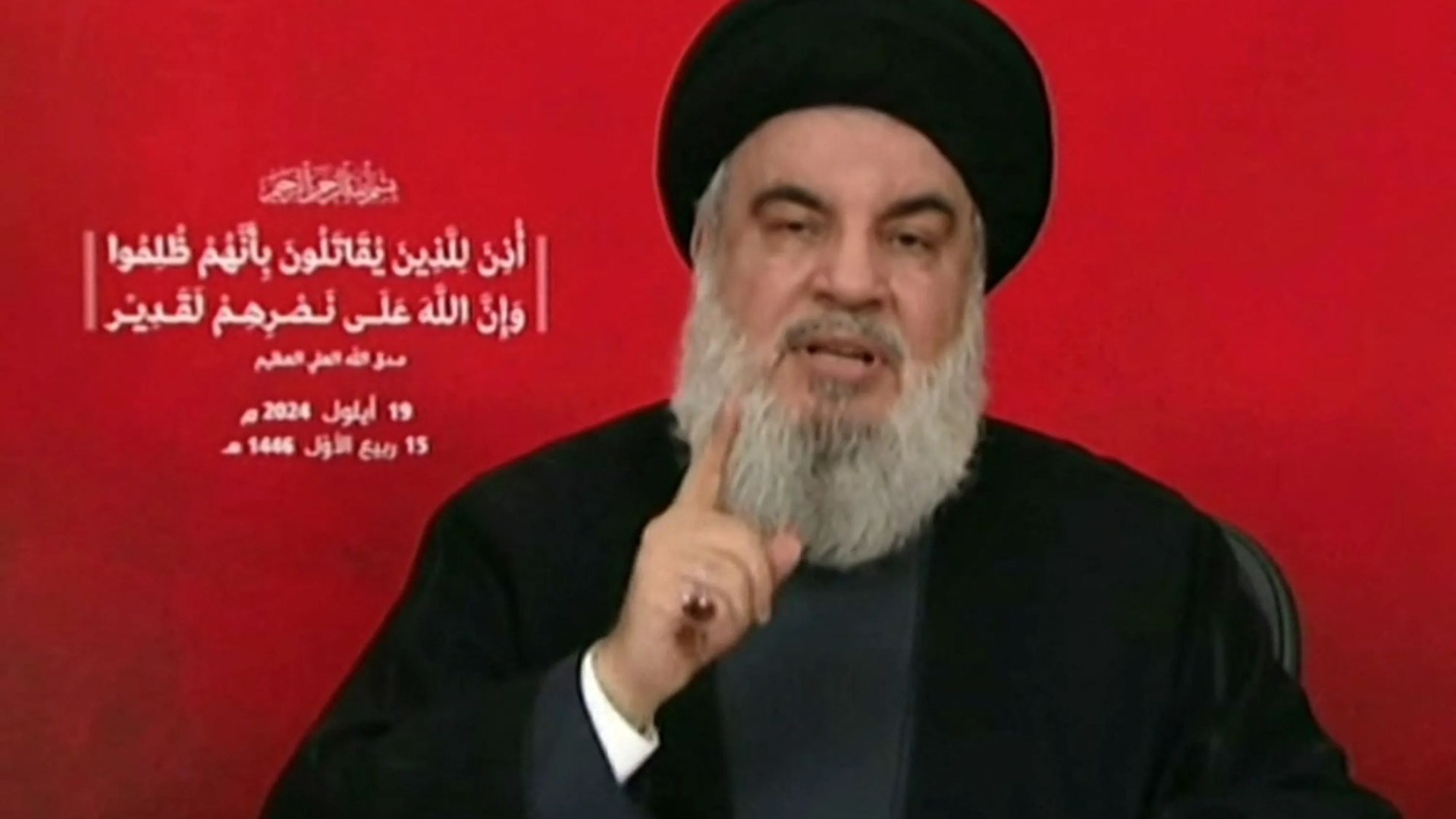ISRAELI forces are wiping out Hezbollah’s chain of command from the ground up as Prime Minister Benjamin Netanyahu vowed to double-down on the terrorists with “full force”.
As Israel rejected a 21-day ceasefire plan, the possibility of all-out war looms large, turning southern Lebanon into a “death zone”.
15

15

15

15
Hundreds of people have this week been killed and half a million forced to flee their homes as Israel has pummelled areas of southern Lebanon used by Hezbollah with airstrikes.
And over the past 11 months, Israel eliminated nearly all of the terror group’s leadership, leaving Hassan Nasrallah alone at the top as he is reportedly hidden in a 50ft deep bunker.
Under Nasrallah, Hezbollah has earned political legitimacy in Lebanon while also engaged in operations that threaten regional stability.
According to IDF reports, his public statements have been marked by extreme anti-Semitism, including saying: “What do the Jews want? They want security and money.
“Throughout history the Jews have been Allah’s most cowardly and avaricious creatures.”
The terror boss is said to present his speeches hidden in bunkers, one of which believed to be 50ft below one of Hezbollah’s headquarters, Saw Beirut reports.
The Hezbollah Secretary General has been living underground for almost five years now.

15

15

15

15
A fugitive who fears for his life and is loyal to his Iranian backers, he remains deep within the soil that he claims to have reclaimed from the Israelis.
And except for a few bodyguards, no one knows where he is.
But Nasrallah’s days in hiding could be coming closer to an end, as IDF troops have been not only wiping out Hamas bosses but swiftly targeting his own men – one by one.
WIPING OUT TERROR
An attack on Monday night in Beirut targeted Hezbollah commander Ali Karaki, raising questions about whether the senior terror leader had been killed in the strike.
After security officials confirmed that Karaki was the target of the strike, Hezbollah released a statement on Monday night stating that Karaki was “fine and, God willing, in full health and wellness and has moved to a safe place.”
The IDF said it will soon release more information on the “targeted strike”.
It was the fourth in Beirut since Hezbollah-led forces started assaulting Israeli settlements and border military installations almost every day on October 8 in support of Hamas during the war in Gaza.
Last Friday, Hezbollah was in chaos after losing two kingpins and 14 commanders in an IDF strike.
Ibrahim Aqil – a terror master on the US most wanted list for 40 years with a $7 million (£526 million) price on his head – was the biggest scalp claimed in the IDF blast on southern Beirut.
Aqil was regarded as the second in command of the Lebanese terror group.
Hezbollah later confirmed Ahmed Wahabi, commander of its elite Radwan Force, had also been killed.
Wahabi was the head of the terror group’s “central training unit,” and was previously top brass in the elite Radwan Force which fought in Syria.

15

15

15
The IDF said after Friday’s strike: “These commanders had been leading and planning the Radwan Force’s attack and infiltration plan into Israeli territory for years, to be executed when given the order.
“Aqil and the commanders eliminated in the strike were responsible for planning, advancing, and executing hundreds of terrorist operations against Israel, including the planning of Hezbollah’s murderous scheme to raid the communities of the Galilee.”
Karaki and senior officer Talal Hamiya were named to take Aqil’s position.
Karaki was a member of the Jihad Council, the highest military council inside Hezbollah, and headed the terror group’s so-called “Southern Front,” which was in charge of its military operations in south Lebanon.
Abu Ali Rida, the leader of the Bader regional division, Taleb Abdullah, the commander of the Nasr regional division, and Muhammad Nasser, the commander of the Aziz regional division, all worked under Karaki.
Both Abdullah and Nasser were killed in Israeli airstrikes in Lebanon, in June 11 and July 3, respectively, reports The Times of Israel.
And on July 30, the IDF wiped out Hezbollah’s top commander, Fuad Shukr, who Israel said was responsible for a deadly rocket attack on Golan Heights that killed 12 children.
Shukr, identified by the IDF as Nasrallah’s right-hand man, has been one of Hezbollah’s key military officials since the organisation was founded by Iran’s Revolutionary Guards over four decades ago.
The United States sanctioned Shukr in 2015, accusing him of playing a key part in the 1983 bombing of the US Marine barracks in Beirut.
On July 31, just a few hours after the Shukr attack, Hamas leader Ismail Haniyeh was slain in a Tehran guesthouse, prompting threats of vengeance from the Palestinian terror group and its Iranian sponsors. Israel has not claimed responsibility for Haniyeh’s killing.
Israel also assassinated Hamas military wing chief Muhammad Deif in an attack in Khan Younis, Gaza, on July 13, and Deputy Hamas chief Saleh al-Arouri in a hit in Beirut on January 2nd.
Separately, on January 8, a strike blamed on Israel reportedly claimed the life of Wissam al-Tawil, the deputy commander of the terror group’s elite Radwan Force, in southern Lebanon.
Hezbollah’s chain of command might be getting eliminated from the ground up, but the terror group’s fighters could still hold some advantage as it might lure Israeli troops into a deadly killing zone.

15

15

15
INTO THE FURNACE
Hidden beneath the villages and rocky hills of southern Lebanon lies Hezbollah’s terror lair – a labyrinth of terror tunnels for miles on end, which is home to a deadly arsenal of missiles.
Inside their underground missile city, Hezbollah fighters can move unseen, store weapons, and launch ambushes, creating a dangerous cat-and-mouse game with the Israeli Defense Forces (IDF).
Estimates place its army in the tens of thousands, and it is believed to possess about 150,000 rockets and missiles of all kinds, The Times reports.
But Hezbollah’s real objective is far more sinister.
The tunnels are designed to pull Israel’s military into a carefully constructed “fire trap,” a zone of devastation where every step forward risks disaster.
With thousands of fighters entrenched in these positions, Hezbollah aims to turn southern Lebanon into a battlefield where Israel’s technological and military dominance could be blunted by the challenges of underground and urban warfare.
This is what Hezbollah refers to as the “fire trap”.
As Israeli forces advance, they’re drawn deeper into unfamiliar and hostile territory.
Meanwhile, Hezbollah fighters are hidden underground, awaiting with advanced weaponry — from precision-guided missiles to lethal anti-tank rockets.

15
The IDF’s Analysis of Hezbollah
by Juliana Cruz Lima, Foreign News Reporter
AN analysis by the Israel Defense Forces (IDF) said that Hezbollah, under the leadership of Hassan Nasrallah, has evolved into a well-armed terrorist organisation, presenting a significant threat to Israeli security.
With strong backing from Iran, Hezbollah’s military capabilities and strategic positioning in Lebanon continue to shape the region’s security dynamics.
Military Strength and Sophisticated Armaments: The IDF assesses that Hezbollah maintains a robust military force with 20,000-25,000 full-time fighters, supported by tens of thousands of reserves.
The organisation’s elite Radwan Unit, trained and equipped by Iran’s Quds Force, is noted for its expertise in conducting operations against Israel, including potential incursions into Israeli territory.
Hezbollah’s vast arsenal consists of over 150,000 rockets and missiles, making it one of the most heavily armed non-state actors globally.
Its weaponry, including Iranian-made Fajr-5 and Zelzal-2 rockets, has the capability to strike deep into Israeli territory, posing a direct and immediate threat.
Advanced Warfare Capabilities: The IDF highlights Hezbollah’s advancements in modern warfare, facilitated by Iranian support.
This includes access to advanced anti-ship missiles, anti-tank weapons, and unmanned aerial vehicles (UAVs).
Hezbollah’s ability to target Israeli naval assets was demonstrated during the 2006 conflict, where it effectively used anti-ship missiles.
The organisation’s UAV capabilities, with ranges up to 400 km, are seen as a growing threat to Israeli airspace and ground operations.
Hassan Nasrallah’s Leadership and Strategy: The IDF acknowledges that Nasrallah has been central to Hezbollah’s development from a militia into a hybrid political-military organization.
Since taking leadership in 1992, Nasrallah has focused on expanding Hezbollah’s rocket arsenal and enhancing its military capabilities.
His extremist ideology, particularly his anti-Semitic rhetoric, reinforces Hezbollah’s hostility towards Israel, while his leadership from hiding underlines the constant threat he poses despite his physical absence from public life.
Major Hezbollah Attacks: Hezbollah has been involved in numerous high-profile terrorist attacks, many of which have targeted Israel and Western interests.
The IDF emphasises that, until 9/11, Hezbollah was responsible for more American deaths than any other terrorist organisation.
It is widely recognised as a global terrorist entity by many nations, including the U.S., the UK, Canada, and Israel.
Hezbollah’s Role in Lebanon’s Crisis: Lebanon’s ongoing economic collapse and political instability have created an environment in which Hezbollah wields disproportionate power.
The IDF warns that Hezbollah’s control and influence over Lebanon’s institutions and its military activities continue to threaten regional stability.
Israel-Hezbollah Conflict: The IDF provides a detailed account of Hezbollah’s ongoing military engagement with Israel, most notably during the 2006 Second Lebanon War.
The conflict, sparked by a Hezbollah attack on Israeli soldiers, resulted in the deaths of hundreds of Hezbollah fighters and significant destruction in Lebanon.
Despite this, Hezbollah has since rebuilt its forces and amassed a larger, more sophisticated arsenal, positioning itself as perhaps the most formidable terrorist organisation in the world.
Conclusion: The IDF concludes that Hezbollah, under Nasrallah’s leadership and backed by Iran, represents a major threat to regional security.
Its advanced military capabilities, particularly its extensive rocket and missile arsenal, coupled with its ideological commitment to attacking Israel, make it a key destabilising force in the Middle East.
As Lebanon faces severe internal challenges, Hezbollah’s role will likely continue to influence the region’s security landscape.




